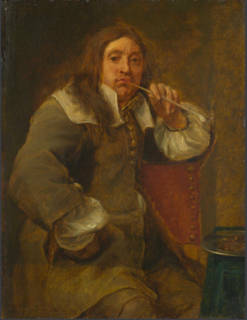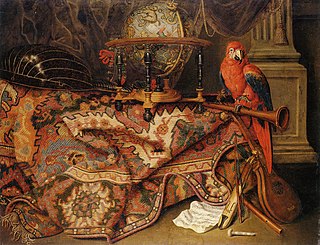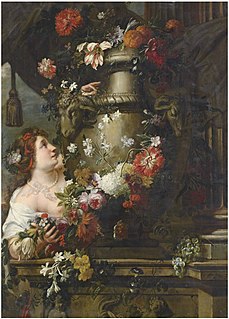
The Flemish artist family Herregouts is believed to comprise 5 members who were artists: David Herregouts and his four sons. [1]

The Flemish artist family Herregouts is believed to comprise 5 members who were artists: David Herregouts and his four sons. [1]
David Herregouts, the founder of the dynasty, was a history painter born in Mechelen in 1603 as the son of Sebastian Herregouts and Elisabeth De Gorter, daughter from a brewing family. He married Cecile Geniets from a butcher's family. He was a pupil of his cousin Salmier and a member of the Guild of St. Luke in his own city in 1624. In 1646 he moved to Roermond, where in 1647 he was received a member of the Guild of St. Luke. He had a successful career in Roermond as he enjoyed the patronage of prominent clients, including the bishop. He died in Roermond in 1663. [1]
David Herregouts had four sons named Hendrik, Willem, Jan Baptist and Maximilian who became painters.
His chief work, "St. Joseph Awakened by an Angel", was painted for the church of St. Catherine in Mechelen. [1]
Hendrik Herregouts (Mechelen, 1633 – Antwerp, 1704) was a history and portrait painter and draughtsman with an international career spanning Italy, Germany and his native Flanders.
Willem Herregouts (probably Mechelen 1640 - Amiens 1711) was a history painter who emigrated to Amiens in France where he was known inter alia as Guillaume Herregosse or Guillaume Hergosse and had a successful career.

Jan Baptist Herregouts [2] (Roermond, c. 1646 – Bruges, 25 November 1721) was a portrait and history painter, etcher and brewer mainly active in Bruges. [1]
Little is known about Maximilian Herregouts other than two works, one entitled Kitchen, in which a woman is busy baking pancakes (1674) and a second entitled Eliezer and Rebecca at the well. [1] [3] [4]

Quentin Matsys (1466–1530) was a Flemish painter in the Early Netherlandish tradition. He was born in Leuven. There is a tradition alleging that he was trained as an ironsmith before becoming a painter. Matsys was active in Antwerp for over 20 years, creating numerous works with religious roots and satirical tendencies. He is regarded as the founder of the Antwerp school of painting, which became the leading school of painting in Flanders in the 16th century. He introduced new techniques and motifs as well as moralising subjects without completely breaking with the tradition.
Michiel Coxie the Elder, Michiel Coxcie the Elder or Michiel van Coxcie, Latinised name Coxius, was a Flemish painter of altarpieces and portraits, a draughtsman and a designer of stained-glass windows, tapestries and prints. He worked for patrons in the principal cities of Flanders. He became the court painter to successively Emperor Charles V and King Philip II of Spain.
Hendrik Herregouts was a Flemish history and portrait painter and draughtsman with an international career spanning Italy, Germany and his native Flanders.

Lucas Faydherbe was a Flemish sculptor and architect who played a major role in the development of the High Baroque in the Southern Netherlands.

Hendrik van Minderhout was a Dutch-born who was primarily active in the Flemish cities Bruges and Antwerp. He painted .marine paintings, harbor scenes, cityscapes, landscapes and architectural paintings. He also collaborated as a staffage painter with Flemish landscape and perspective painters.

Cornelis Huysmans was a Flemish landscape painter who was active in Antwerp, Brussels and Mechelen. Huysmans held a foremost position in Flemish landscape painting in the late 17th and early 18th century and was particularly known for his pseudo-Italianate landscapes with mountains in the background, which show the influence of Nicolas Poussin and Jacques d'Arthois.

Peter, Peeter or Pieter Franchoys or Francois was a Flemish Baroque painter, who is mainly known for his portraits and religious paintings.

Willem Gabron or Guiliam Gabron, was a Flemish Baroque still life painter, who worked in a wide range of genres including fruit pieces, vanitas still lifes, flower still lifes, game pieces and breakfast pieces. Gabron was also a gifted animalier and often included living animals in his still life scenes. He initially worked in a monochrome style but developed a more colourful palette after a long stay in Italy.
Verdussen was a dynasty of printers in Antwerp, starting with Hieronymus Verdussen I in the late sixteenth century, and ending around 1800. Many other printers in Antwerp were also related to the Verdussens through marriage. They specialized in religious works and works in Spanish, but also published newspapers, almanachs, poetry, scientific works, .... By the end of the 17th century, they produced about 21% of the Spanish books printed in the Netherlands, and with 5 presses was second only to Moretus in Antwerp. In 1876, the Verdussenstraat was named after the family in Antwerp.

Willem Jacob Herreyns was a Flemish painter of history subjects and portraits. He is regarded as one of the last painters in the tradition of the Flemish Baroque and the last follower of Peter Paul Rubens.

Jacob van Oost or Jacob van Oost the Elder (1603–1671) was a Flemish painter of history paintings and portraits. He was the most important painter of Bruges in the 17th century through his portraits of members of the local bourgeois and his many altarpieces made in the spirit of the Counter Reformation. He also created genre paintings of musicians and card players for the open market.

Peter Ykens, was a Flemish painter mainly known for his history paintings and portraits. He regularly collaborated with specialist still painters and landscape artists for whose works he provided the staffage.

Pieter Valckx was a Flemish sculptor. He is mainly known for church furniture in the churches in Mechelen. He was one of the last representatives of the Flemish Baroque.

Jan Baptist Morel or Jean Baptiste Morel was a Flemish still life painter who specialized in flower pieces and garlands. He was a successful artist who worked in Antwerp and Brussels.

Jan Baptist Herregouts was a Flemish painter, etcher, printmaker and brewer. He is known for his portraits, history subjects and allegorical scenes.

Jan Baptist van Meunincxhove was a Flemish painter of cityscapes, architectural paintings, marine views and group portraits who was active in Bruges. Without being original, he maintained a high standard of painting at a time when art in Flanders was in decline.

Willem van den Broecke, Willem van den Broeck or Guillelmus Paludanus was a Flemish sculptor, painter, draughtsman and architect. He was a scion of a family of artists, which had its origins in Mechelen and some members of which later moved to Antwerp. Willem was active in Antwerp and also worked and likely trained in Italy for a long period. He was known for his small scale works, many of which were executed in alabaster. He was, along with Cornelis Floris, the leading sculptor in Antwerp in the second half of the 16th century. He was also one of the designers of the Antwerp City Hall. He enjoyed the patronage of an elite international clientele of church institutions, Spanish nobility, princes of Protestant territories as well as patricians from Augsburg.

Willem Kerricx or Willem Kerricx the Elder was a Flemish sculptor active in Antwerp. His works comprise mostly sculptured church furniture, individual sculptures, both portrait busts as well as statues of saints for churches and funerary monuments. His style shows the transition from the highly dramatic expressiveness of the Antwerp late Baroque towards a more gracious and elegant Rococo style. He operated a large workshop in Antwerp which was continued by his son into the middle of the 18th century.
Herregouts a Flemish artist family comprising 5 members who were artists: David Herregouts and his four sons as follows: